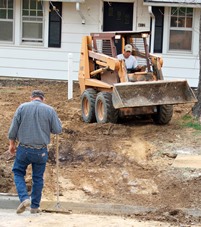With Australia’s retirement age set to rise to 70, will older tradies be able to keep working? A 2012 federal government skills shortage report highlighted only three trades to be in short supply as a result of the ongoing economic climate. Academic literature, furthermore, tends to focus on the retention and training of younger workers to fill the gaps within Australia’s sixth youngest industry. WOW’s Dr Teresa Marchant has sought in a recent study, to place a spotlight on the ageing male tradie – the norm – in construction, how they negotiate this inevitable reality, the influences of and perceptions about masculinity as this plays out, and the value of retaining such long-learned skills.
“There is a gap in the ageing workforce literature concerning the construction industry because it considers mainly organisational views”, Dr Marchant says. “More attention should be paid to self-employed tradesmen and the focus should be on ageing”.
Teresa used a conversational face-to-face interview style to obtain in-depth responses from twenty self-employed tradies from the private domestic construction industry on the East coast of Australia. And what did she find? Well, five themes emerged.

The first concerned, of course, age, which most poignantly was not defined by chronology, but by the tradesman’s capacity – underpinned by his physical health, strength and skill – to perform his work. Diminished ‘capacity’ using these benchmarks, furthermore, also earmarked their loss of masculinity. By contrast, despite an average age of 51 and with participants ranging from 32-77 years old, interviewees held no concerns about age discrimination (although the role of personal networks, contacts and their reputation was highlighted as mitigating factors).
A second theme centred around the physical process and impact of biological ageing, with tradies acknowledging the degenerative nature of work on their body’s core and limbs, and a general cumulative weariness. Finding a silver lining however, interviewees often affirmed that their work kept them fit, seguing into a third theme around the strategies employed to ‘stay in the game’. Self-initiated as an injury prevention/ longevity measure, and despite evident downfalls such as raised costs, these centred around bringing in extra labour, the increased use of mechanical aids to perform manual tasks, selecting, conducting and scheduling less burdensome tasks, and in some instances, purposefully attending to physical self-care (this ranged from no more than a reliance on the exercise and fitness from the work itself, to pain-relieving medication and additional aerobic exercise and yoga).
A cross-over in the fourth and fifth themes emerged around tradesmen’s retirement and other industry exit options, and the financial considerations of ageing in such an industry. For a variety of reasons, including financial ones like inadequate superannuation, retirement was not a goal for the twenty interviewees. When it inevitably occurs however, it is anticipated to play out in a protracted manner – around one-third of the interviewees wished to continue working into older age – rather than an abrupt stop at a pre-determined date.
“There is no doubt that these tradesmen were experiencing the effects of ageing even if they were doing everything in their power to resist….The paradox associated with attempting to maintain masculinity in the face of physical decline was evident,” adds Teresa.
So what can be done to enhance the working experience of tradies?
Dr Marchant suggests by acknowledging that age does not necessarily discriminate against the self-employed male majority of the industry, organisations and national policies should address the value of retaining the experienced within, whilst at the same time appreciating the influence of masculinity that is measured as capacity through fitness and strength. Introducing national and public initiatives that might offer finance and career planning; compulsory superannuation requirements; an industry future fund that seeks to educate tradesmen about their exit options and offer scholarships and loans for retraining or career transition; and the creation of community-focussed, informal conduits for information around the same, are great places to start.
Future research is also advocated. Whilst Teresa notes the autonomous nature of the self-employed tradesman can make it difficult to access them for research, licensing bodies, unions and industry employer organisations may, she says, be avenues for tapping into larger numbers of contributors. Longitudinal research that considers changing industry and worker attitudes (including inadvertently those about other construction industry non-mainstream groups like women or those with disabilities), would be interesting, as would investigations into older workers’ attitudes about younger ones, changes in skill requirements, the impact of technological innovation in the industry, and of course, career progression.
Comprehensive findings from Dr Marchant’s study can be found in her 2013 Construction Management and Economics journal article entitled, ‘Keep going: career perspectives on ageing and masculinity of self-employed tradesmen in Australia’.
